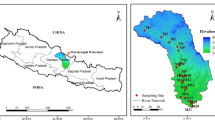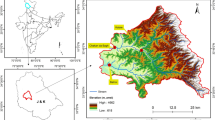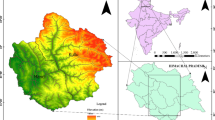Abstract
Climate variability and change play a vital role in the susceptible system of the Satluj River basin located in western Himalaya. The Satluj River is providing precious water resources for the hydropower generation and intense agriculture in the basin. The present study provides insight into the trends in snowfall, snow cover area, rainfall and temperature (T min and T max) with subsequent effect on river discharge. Mann–Kendall test and Sen’s slope estimator were used to evaluate annual, seasonal and monthly trends. The snowfall has decreased over the studied period of 33 years with the mean snowfall exhibiting decreasing trends annually, seasonally as well as monthly. Out of the total data, 14 stations revealed negative trends with significant trends at 8 stations. Highest number of stations with negative trends occurred during post-monsoon season. The decreasing snowfall has resulted in decrease in snow cover area in the basin. On the other hand, the annual and seasonal rainfall has increased significantly except for winter season. Station-wise, rainfall revealed mixed nature of trends with feeble increasing trends >1600 m asl elevation. Consequently, the temperature has increased with dominantly significant trends in T min. The T min showed significant rising trends at most of the stations located >1000 m asl elevation and winter season. The temperature particularly T min may be a dominant factor in controlling the trends in snowfall, snow cover area and rainfall trends. Subsequently, the annual discharge has decreased with significant decreasing trends during monsoon and post-monsoon seasons. Moreover, during regression analysis, it was observed that with increase in temperature, snowfall has decreased and rainfall increased. The negative correlation between snowfall and rainfall also substantiated the fact that the snowfall has decreased with increase in rainfall. In addition, the trend analysis also suggested the coincidence of decline in snowfall and increase in rainfall, reflecting the shifting of precipitation from solid to liquid in the basin. Thus, a decrement in snowfall along with moderate increment in rainfall and significant rise in temperature particularly T min was observed in the basin. Nevertheless, a clear link exists between the trends in climatic parameters and river discharge in the basin.







Similar content being viewed by others
References
Aziz OIA, Burn DH (2006) Trends and variability in the hydrological regime of the Mackenzie River Basin. J Hydrol 319:282–294
Barnett TP, Dumenil L, Latif M (1989) The effect of Eurasian snow cover on regional and global climate variations. J Atmos Sci 46(5):661–685
Berthier E, Arnaud Y, Kumar R, Ahmad S, Wagnon P, Chevallier P (2007) Remote sensing estimates of glacier mass balances in the Himachal Pradesh (Western Himalaya, India). Remote Sens Environ 108(3):327–338
Bhutiyani MR, Kale VS, Pawar NJ (2007) Long-term trends in maximum, minimum and mean annual air temperatures across the Northwestern Himalaya during the twentieth century. Clim Change. doi:10.1007/s10584-006-9196-1
Bhutiyani MR, Kale VS, Pawar NJ (2008) Changing stream flow patterns in the rivers of northwestern Himalaya: implications of global warming in the 20th century. Curr Sci 95(5):618–626
Bhutiyani MR, Kal VS, Pawar NJ (2009) Climate change and the precipitation variations in the northwestern Himalaya: 1866–2006. Int J Climatol 30(4):535–548
Bidin K, Chappell NA (2006) Characteristics of rain events at an inland locality in northeastern Borneo, Malaysia. Hydrol Process 20:3835–3850
Bolch T, Kulkarni AK, Kääb A, Huggel C, Paul F, Cogley G, Frey H, Kargel JS, Fujita K, Scheel M, Stoffel M, Bajracharya S (2012) The state and fate of Himalayan glaciers. Science 336:310–314
Burgueño A, Serra C, Lana X (2004) Monthly and annual statistical distributions of daily rainfall at the Fabra Observatory (Barcelona, NE Spain) for the years 1917–1999. Theor Appl Climatol 77:57–75. doi:10.1007/s00704-003-0020-9
Cannarozzo M, Noto LV, Viola F (2006) Spatial distribution of rainfall trends in Sicily (1921–2000). Phys Chem Earth 31:1201–1211
Cao L, Zhang Y, Shi Y (2011) Climate change effect on hydrological processes over the Yangtze River Basin. Quat Int 244:202–210
Dash SK, Jenamani RK, Kalsi SR, Panda SK (2007) Some evidence of climate change in twentieth-century India. Clim Change 85:299–321
Derksen C, LeDrew E, Walker A, Goodison B (2000) Winter season variability in North American Prairie SWE distribution and atmospheric circulation. Hydrol Process 14:3273–3290
Dimri AP, Kumar A (2008) Climatic variability of weather parameters over the western Himalayas: a case study. In: Proceedings of the National Snow Science Workshop, 11–12 January (2008), Chandigarh, Chandigarh, India. Snow and Avalanche Study Establishment
Dimri AP, Mohanty UC (2007) Location specific prediction of maximum and minimum temperature over the Western Himalayas. Meteorol Appl 14:79–93
Dore MHI (2005) Climate change and changes in global precipitation patterns: what do we know? Environ Int 31:1167–1181
Dozier J (1989) Spectral signature of alpine snow cover from the Landsat Thematic Mapper. Remote Sens Environ 28:9–22
Dunne SS, Lynch P, Grath RM et al (2008) The impacts of climate change on hydrology in Ireland. J Hydrol 356:28–45
Eltahir ABE (1992) Drought frequency analysis of annual rainfall series in central and western Sudan. Hydrol Sci J 3:6
Frei A, Robinson DA (1999) Northern Hemisphere snow extent: regional variability 1972–1994. Int J Climatol 19:1535–1560
Fujita K, Ageta Y (2000) Effect of summer accumulation on glacier mass balance on the Tibetan Plateau revealed by mass balance model. J Glaciol 46(153):244–252
Gadgil S, Joseph PV (2003) On breaks of the Indian monsoon. Proc Indian Acad Sci (Earth Planet Sci Lett) 112:529–558
Goodison BE, Walker AE (1993) Use of snow cover derived from satellite passive microwave data as an indicator of climate change. Ann Glaciol 17:137–142
Goswami BN, Venugopal V, Sengupta D, Madhusoodanan MS, Xavier PK (2006) Increasing trend of extreme rain events over India in a warming environment. Science 314:1442–1445. doi:10.1126/science.1132027
Groisman PY, Karl TR, Knight RW (1994) Observed impact of snow cover on the heat balance and the rise of continent spring temperature. Science 263(14):198–200
Haeberli W, Zemp M, Hoelzle M, Frauenfelder R, Hoelzle M, Kaab A (2005) Fluctuations of glaciers 1995–2000, vol 8. UNESCO, Paris. http://www.geo.uzh.ch/microsite/wgms/fog/fog8.pdf
Hall DK, Riggs GA, Salomonson VV (1995) Development of methods for mapping global snow covers using Moderate Resolution Imaging Spectroradiometer (MODIS) data. Remote Sens Environ 54(2):127–140
Hall DK, Riggs GA, Salomonson VV, DiGirolamo NE, Bayr KJ (2002) MODIS snow cover products. Remote Sens Environ 83:181–194
Hall DK, Riggs GA, Salomonson VV (2007) (updated weekly) MODIS/Terra Snow Cover 8-Day L3 Gobal 500 m Grid V005. National Snow and Ice Data Centre. Digital media, Boulder
Hasnain SI (2002) Himalayan glaciers meltdown: impact on South Asian Rivers. Int As Hydrol Sci Publ 274:417–423
IPCC (2007) Climate change 2007: the physical science basis, contribution of working group I to the fourth assessment report of the Intergovernmental Panel on Climate Change. Cambridge University Press, Cambridge, p 996
Jaagus J (2006) Climatic changes in Estonia during the second half of the 20th century in relationship with changes in large-scale atmospheric circulation. Theor Appl Climatol 83:77–88
Jain SK, Kumar N, Ahmed T (1998) SLURP model and GIS for estimation of runoff in a part of Satluj catchment, India. Hydrol Sci J 43(6):875–884
Jain SK, Ajanata G, Saraf AK (2008a) Accuracy assessment of MODIS, NOAA and IRS data in snow cover mapping under Himalayan condition. Int J Remote Sens 29(20):5863–5878
Jain SK, Ajanata G, Saraf AK (2008b) Assessment of snowmelt runoff using remote sensing and effect of climate change on runoff. Water Res Manag 24:1763–1777
Jain SK, Goswami A, Saraf AK (2010) Assessment of snowmelt runoff using remote sensing and effect of climate change on runoff. Water Res Manag 24:1763–1777
Kaser G, Cogley JG, Dyurgerov MB, Meier MF, Ohmura A (2006) Mass balance of glaciers and ice caps: consensus estimates for 1961–2004. Geophys Res Lett. doi:10.1029/2006GL027511
Kendall MG (1962) Rank correlation methods, 3rd edn. Hafner Publishing Company, New York, p 128
Khattak M, Babel M, Sharif M (2011) Hydrometeorological trends in the upper Indus River basin in Pakistan. Clim Res 46(2):103–119
Kulkarni AV, Alex S (2003) Estimation of recent glacial variations in Baspa Basin using remote sensing technique. J Indian Soc Remote Sens 31(2):81–90
Kulkarni AV, Bahuguna IM (2002) Glacial retreat in the Baspa basin, Himalayas, monitored with satellite stereo data. J Glaciol 48:171–172
Kulkarni AV, Rathore BP, Suja A (2004) ‘Monitoring of glacial mass balance in the Baspa basin using Accumulation Area Ratio method. Curr Sci 86(1):101–106
Kulkarni AV, Bahuguna IM, Rathore BP, Singh SK, Randhawa SS, Sood RK, Dhar S (2007) Glacial retreat in Himalaya using Indian remote sensing satellite data. Curr Sci 92(1):69–74
Lillesand TM, Kiefer RW, Chipman JW (2004) Remote sensing and image interpretation, 5th edn. Wiley, Lucknow
Liu X, Cheng Z, Yan L, Yin ZY (2009) Elevation dependency of recent and future minimum surface air temperature trends in the Tibetan Plateau and its surroundings. Glob Planet Change 68:164–174
Loukas A, Quick MC (1996) The effect of climate change on floods in British Columbia. Nordic Hydrol 30:231–256
Mann HB (1945) Non-parametric tests against trend. Econometrica 13:245–259
Mccabe GJ, Wolock DM (2010) Long-term variability in Northern Hemisphere snow cover and associations with warmer winters. Clim Change 99:141–153
Meissner S, Reller A (2005) Sustainable management of Alpine water potentials. J Alp Res 93(3):5–29
Mir RA, Jain SK, Saraf AK, Goswami A (2013a) Detection of changes in glacier mass balance using satellite and meteorological data in Tirungkhad Basin located in western Himalaya. J Indian Soc Remote Sens. doi:10.1007/s12524-013-0303-2
Mir RA, Jain SK, Saraf AK, Goswami A (2013b) Glacier changes using satellite data and effect of climate in Tirungkhad basin located in western Himalaya. Geocarto Int. doi:10.1080/10106049.2012.760655
Mir RA, Jain SK, Saraf AK, Goswami A (2015) Declines in snowfall in response to temperature in Satluj basin, western Himalaya. J Earth Syst Sci 124(2):365–382
Modarres R, Silva VPR (2007) Rainfall trends in arid and semi-arid regions of Iran. J Arid Environ 70:344–355
Odekunle TO, Balogun EE, Ogunkoya OO (2005) On the prediction of rainfall onset and retreat dates in Nigeria. Theor Appl Climatol 81:101–112. doi:10.1007/s00704-004-0108-x
Partal T, Kahya E (2006) Trend analysis in Turkish precipitation data. Hydrol Process 20:2011–2026
Partap U, Partap T (2002) Warning signals from the Apple Valleys of the Hindu Kush–Himalayas: productivity concerns and pollination problems. In: Shreshtha ABM (ed) Centre for Integrated Mountain Development (ICIMOD) Publication. Kathmandu, 104 p
Philip G, Sah MP (2004) Mapping repeated surges and retread of glaciers using IRS-1C/1D data: a case study of Shaune Garang Glacier, northwestern Himalaya. Int J Appl Earth Obs Geoinf 6(2):127–141
Pimentel D, Berger B, Filibrto D, Newton M, Wolfe B, Karabinakis E, Cark S, Poon E, Abbett E, Nandagopal S (2004) Water resources: agricultural and environmental issues. BioScience 54(10):909–918
Rajeevan M, Bhate J, Kale JD, Lal B (2006) High resolution daily gridded rainfall data for the Indian region: analysis of break and active monsoon spells. Curr Sci 91:3
Rana RS, Bhagat RM, Kalia A, Sood C (2006) Inventory of two decades for glaciers and glacial lakes in Satluj River Basin of Himachal Pradesh. J Agric Phys 6(1):28–34
Rio S, Penasa A, Fraile R (2005) Analysis of recent climatic variations in Castile and Leon (Spain). Atmos Res 73:69–85
Salmi T, Määttä A, Anttila P, Ruoho-Airola T, Amnell T (2002) Detecting trends of annual values of atmospheric pollutants by the Mann–Kendall test and Sen’s slope estimates—the excel template application MAKESENS, Ilmatieteen laitos, Meteorologiska Institutet, Finnish Meteorological Institute
Salomonson VV, Appel I (2006) Development of the Aqua MODIS NDSI fractional snow cover algorithm and validation results. IEEE Trans Geosci Remote Sens 44(7):1747–1756
Seager R, Vecchi GA (2010) Greenhouse warming and the 21st century hydroclimate of southwestern North America. Proc Natl Acad Sci USA 107:21277–21282
Sen PK (1968) Estimates of the regression coefficient based on Kendall’s tau. J Am Stat As 63(324):1379–1389
Serreze M, Walsh J, Chapin F, Osterkamp T, Dyurgerov M, Romanosky V, Oechel W, Morison J, Zhang T, Barry R (2000) Observational evidence of recent change in the northern high-latitude environment. Clim Change 46:159–207
Sharma RH, Shakya NM (2006) Hydrological changes and its impact on water resources of Bagmati watershed. Nepal J Hydrol 327:315–322
Shekhar MS, Chand H, Kumar S, Srinivasan K, Ganju A (2010) Climate-change studies in the western Himalaya. Ann Glaciol 51(54):105–112
Shrestha UB, Gautam S, Bawa KS (2012) Widespread climate change in the Himalayas and associated changes in local ecosystems. PLoS ONE 7(5):e36741
Singh CV (1998) Relationships between rainy days, mean daily intensity and seasonal rainfall in normal, flood and drought years over India. Adv Atmos Sci 15(3):424–432
Singh P, Bengtsson L (2004) Hydrological sensitivity of a large Himalayan basin to climate change. Hydrol Process 18:2363–2385
Singh P, Jain SK (2002) Snow and glacier melt in the Satluj River at Bhakra dam in the Western Himalayan region. Hydrol Sci J 47:93–106
Singh P, Kumar N (1997) Impact assessment of climate change on the hydrological response of a snow and glacier melt runoff dominated Himalayan River. J Hydrol 193:316–350
Singh N, Sontakke NA (1999) On the variability and prediction of rainfall in the post-monsoon season over India. Int J Climatol 19:309–339
Sinha RKC, Mukhopadhya RK, Chowdhary SK (1997) Trend in maximum and minimum temperature and sea level pressure over India; Intromet 1997 IIT Delhi, Hauz Khas, New Delhi
Smith I (2004) An assessment of recent trends in Australian rain. Aust Meteorol Mag 53:163–173
Stewart IT (2009) Changes in snowpack and snowmelt runoff for key mountain regions. Hydrol Process 23:78–94
Tao H, Gemmer M, Bai Y, Su B, Mao W (2011) Trends of stream flow in the Tarim River Basin during the past 50 years: human impact or climate change. J Hydrol 400:1–9
Thayyen RJ, Gergan JT, Dobhal DP (2005) Monsoonal control on glacier discharge and hydrographic characteristics, a case study of Dokriani glacier, Garhwal Himalaya, India. J Hydrol 36(1–4):37–49
Trenberth KE (2011) Changes in precipitation with climate change. Clim Res 47:123–138. doi:10.3354/cr00953
Vohra CP (1981) Note on recent glaciological expedition in Himachal Pradesh. Geol Surv India Spec 6:26–29p
Wang L, Li Z, Wang F, Edwards R (2014) Glacier shrinkage in the Ebinur lake basin, Tien Shan, China, during the past 40 years. J Glaciol 60(220):245–254. doi:10.3189/2014JoG13J023
Whitfield PH, Fraser D, Cohen S (2003) Climate change impacts on water in Georgia Basin/Puget Sound. Can Water Resour J 28:523–529
Woodwell GM (2004) Mountains: top down. Ambio Special Report 13:35–38
Acknowledgments
Mr. Riyaz Ahmad Mir was supported by the University Grants Commission, India, under the CSIR-JRF Fellowship. First, thanks are due to BBMB for providing hydrometeorological data and NASA for making the MODIS datasets freely available under the umbrella USGS Web server. Special thanks to reviewers for their significant comments for improving the quality of the paper. Thanks to Ms. Neha Jain (NIH, Roorkee) for her frequent and timely assistance.
Author information
Authors and Affiliations
Corresponding author
Rights and permissions
About this article
Cite this article
Mir, R.A., Jain, S.K. & Saraf, A.K. Analysis of current trends in climatic parameters and its effect on discharge of Satluj River basin, western Himalaya. Nat Hazards 79, 587–619 (2015). https://doi.org/10.1007/s11069-015-1864-x
Received:
Accepted:
Published:
Issue Date:
DOI: https://doi.org/10.1007/s11069-015-1864-x




